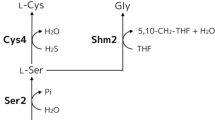Abstract
A novel extracellular glutathione fermentation method using engineered Saccharomyces cerevisiae was developed by following three steps. First, a platform host strain lacking the glutathione degradation protein and glutathione uptake protein was constructed. This strain improved the extracellular glutathione productivity by up to 3.2-fold compared to the parental strain. Second, the ATP-dependent permease Adp1 was identified as a novel glutathione export ABC protein (Gxa1) in S. cerevisiae based on the homology of the protein sequence with that of the known human glutathione export ABC protein (ABCG2). Overexpression of this GXA1 gene improved the extracellular glutathione production by up to 2.3-fold compared to the platform host strain. Finally, combinatorial overexpression of the GXA1 gene and the genes involved in glutathione synthesis in the platform host strain increased the extracellular glutathione production by up to 17.1-fold compared to the parental strain. Overall, the metabolic engineering of the glutathione synthesis, degradation, and transport increased the total (extracellular + intracellular) glutathione production. The extracellular glutathione fermentation method developed in this study has the potential to overcome the limitations of the present intracellular glutathione fermentation process in yeast.




Similar content being viewed by others
References
Alfafara CG, Kanda A, Shioi T, Shimizu H, Shioya S, Suga K (1992) Effect of amino acids on glutathione production by Saccharomyces cerevisiae. Appl Microbiol Biotechnol 36:538–540
Bourbouloux A, Shahi P, Chakladar A, Delrot S, Bachhawat AK (2000) Hgt1p, a high affinity glutathione transporter from the yeast Saccharomyces cerevisiae. J Biol Chem 275:13259–13265
Brechbuhl HM, Gould N, Kachadourian R, Riekhof WR, Voelker DR, Day BJ (2010) Glutathione transport is a unique function of the ATP-binding cassette protein ABCG2. J Biol Chem 285:16582–16587
Chen DC, Yang BC, Kuo TT (1992) One-step transformation of yeast in stationary phase. Curr Genet 21:83–84
Decottignies A, Goffeau A (1997) Complete inventory of the yeast ABC proteins. Nat Genet 15:137–145
Dhaoui M, Auchère F, Blaiseau PL, Lesuisse E, Landoulsi A, Camadro JM, Haguenauer-Tsapis R, Belgareh-Touzé N (2011) Gex1 is a yeast glutathione exchanger that interferes with pH and redox homeostasis. Mol Biol Cell 22:2054–2067
Dröge W, Breitkreutz R (2000) Glutathione and immune function. Proc Nutr Soc 59:595–600
Flohé L (1985) The glutathione peroxidase reaction: molecular basis of the antioxidant function of selenium in mammals. Curr Top Cell Regul 27:473–478
Hara KY, Shimodate N, Hirokawa Y, Ito M, Baba T, Mori H, Mori H (2009) Glutathione production by efficient ATP-regenerating Escherichia coli mutants. FEMS Microbiol Lett 297:217–224
Hara KY, Kim S, Yoshida H, Kiriyama K, Kondo T, Okai N, Ogino C, Fukuda H, Kondo A (2012a) Development of a glutathione production process from proteinaceous biomass resources using protease-displaying Saccharomyces cerevisiae. Appl Microbiol Biotechnol 93:1495–1502
Hara KY, Kiriyama K, Inagaki A, Nakayama H, Kondo A (2012b) Improvement of glutathione production by metabolic engineering the sulfate assimilation pathway of Saccharomyces cerevisiae. Appl Microbiol Biotechnol (in press)
Ishii J, Izawa K, Matsumura S, Wakamura K, Tanino T, Tanaka T, Ogino C, Fukuda H, Kondo A (2009) A simple and immediate method for simultaneously evaluating expression level and plasmid maintenance in yeast. J Biochem 145:701–708
Ito H, Fukuda Y, Murata K, Kimura A (1983) Transformation of intact yeast cells treated with alkali cations. J Bacteriol 153:163–168
Li Y, Wei G, Chen J (2004) Glutathione: a review on biotechnological production. Appl Microbiol Biotechnol 66:233–242
Meister A, Andersen ME (1983) Glutathione. Annu Rev Biochem 52:711–760
Miyake T, Hazu T, Yoshida S, Kanayama M, Tomochika K, Shinoda S, Ono B (1998) Glutathione transport systems of the budding yeast Saccharomyces cerevisiae. Biosci Biotechnol Biochem 62:1858–1864
Penninckx MJ (2002) An overview on glutathione in Saccharomyces versus non-conventional yeasts. FEMS Yeast Res 2:295–305
Ray S, Watkins DN, Misso NL, Thompson PJ (2002) Oxidant stress induces gamma-glutamylcysteine synthetase and glutathione synthesis in human bronchial epithelial NCI-H292 cells. Clin Exp Allergy 32:571–577
Rolseth V, Djurhuus R, Svardal AM (2002) Additive toxicity of limonene and 50 % oxygen and the role of glutathione in detoxification in human lung cells. Toxicology 170:75–88
Singh RJ (2002) Glutathione: a marker and antioxidant for aging. J Lab Clin Med 140:380–381
Suzuki T, Yokoyama A, Tsuji T, Ikeshima E, Nakashima K, Ikushima S, Kobayashi C, Yoshida S (2011) Identification and characterization of genes involved in glutathione production in yeast. J Biosci Bioeng 112:107–113
Tate S, Meister A (1981) γ-Glutamyltranspeptidase: catalytic, structural and functional aspects. Mol Cell Biochem 39:357–368
Vartanyan LS, Gurevich S, Kozachenko AI, Nagler LG, Lozovskaya EL, Burlakova EB (2000) Changes in superoxide production rate and in superoxide dismutase and glutathione peroxidase activities in subcellular organelles in mouse liver under exposure to low doses of low-intensity radiation. Biochem Mosc 65:442–446
Wei G, Li Y, Du G, Chen J (2003) Effect of surfactants on extracellular accumulation of glutathione by Saccharomyces cerevisiae. Process Biochem 38:1133–1138
Wen S, Zhang T, Tana T (2004) Utilization of amino acids to enhance glutathione production in Saccharomyces cerevisiae. Enz Microbiol Technol 35:501–507
Yoshida H, Hara KY, Kiriyama K, Nakayama H, Okazaki F, Matsuda F, Ogino C, Fukuda H, Kondo A (2011) Enzymatic glutathione production using metabolically engineered Saccharomyces cerevisiae as a whole-cell biocatalyst. Appl Microbiol Biotechnol 91:1001–1006
Yoshida K, Hariki T, Inoue H, Nakamura T (2002) External skin preparation for whitening. JP Patent 2, 002, 284, 664
Acknowledgments
We are grateful to Dr. J. Ishii (Organization of Advanced Science and Technology, Kobe University) for providing us with the pGK plasmid series. This study was supported by the Special Coordination Funds for Promoting Science and Technology, Creation of Innovation Centers for Advanced Interdisciplinary Research Areas (Innovative Bioproduction Kobe), MEXT, Japan. K.Y. Hara was supported by a Grant-in-Aid for Young Scientists (B) (22760608).
Author information
Authors and Affiliations
Corresponding author
Additional information
Kentaro Kiriyama and Kiyotaka Y. Hara contributed equally to this work.
Rights and permissions
About this article
Cite this article
Kiriyama, K., Hara, K.Y. & Kondo, A. Extracellular glutathione fermentation using engineered Saccharomyces cerevisiae expressing a novel glutathione exporter. Appl Microbiol Biotechnol 96, 1021–1027 (2012). https://doi.org/10.1007/s00253-012-4075-3
Received:
Revised:
Accepted:
Published:
Issue Date:
DOI: https://doi.org/10.1007/s00253-012-4075-3




